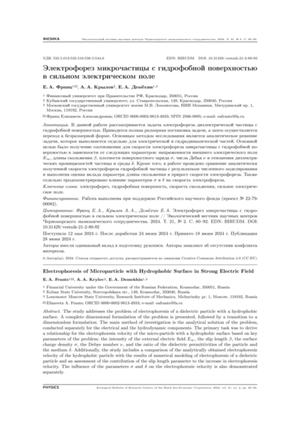Электрофорез микрочастицы с гидрофобной поверхностью в сильном электрическом поле
УДК
532.5.013:532.516:538.5:544.6DOI:
https://doi.org/10.31429/vestnik-21-2-80-92Аннотация
В работе рассмотрена задача электрофореза диэлектрической частицы с гидрофобной поверхностью. Приводится полная размерная постановка задачи и производится переход к безразмерной постановке. Основным методом исследования является аналитическое решение задачи, которое производится отдельно для электрической части и отдельно для гидродинамической части задачи. Основной задачей являлся вывод соотношения для скорости электрофореза микрочастицы с гидрофобной поверхностью в зависимости от основных параметров задачи: напряженности внешнего электрического поля
Ключевые слова:
электрофорез, гидрофобная поверхность, скорость скольжения, сильное электрическое полеИнформация о финансировании
Работа выполнена при поддержке Российского научного фонда, проект № 22-79-00082
Библиографические ссылки
- Stone, H.A., Stroock, A., Ajdari, A., Engineering flows in small devices: Microfluidics toward a lab-on-a-chip. Annu. Rev. Fluid Mech., 2004, vol. 36, pp. 381–411.
- Squires, T.M., Quake, S., Microfluidics: Fluid physics at the nanoliter scale. Rev. Mod. Phys., 2005, vol. 77, p. 977. DOI: 10.1103/RevModPhys.77.977
- Lauga, E., Brenner, M.P., Stone, H.A., Microfluidics: The no-slip boundary condition. In: Tropea, C., Yarin, A., Foss, J.F. (eds), Handbook of Experimental Fluid Dynamics. Springer, New York, 2007, pp. 1219–1240. DOI: 10.1007/978-3-540-30299-519
- Neto, C., Evans, D.R., Bonaccurso, E., Butt, H.-J., Craig, V.S.J., Boundary slip in Newtonian liquids: A review of experimental studies. Rep. Prog. Phys., 2005, vol. 68, p. 2859. DOI: 10.1088/0034-4885/68/12/R05
- Vinogradova, O., Slippage of water over hydrophobic surfaces. Int. J. Min. Process., 1999, vol 56, pp. 31–60. DOI: 10.1016/S0301-7516(98)00041-6
- Churaev, N.V., Ralston, J., Sergeeva, I.P., Sobolev, V.D., Electrokinetic properties of methylated quartz capillaries. Adv. Colloid Interface Sci., 2002б vol. 96, p. 265. DOI: 10.1016/s0001-8686(01)00084-7
- Bouzigues, C.I., Tabeling, P., Bocquet, L., Nanofluidics in the Debye Layer at Hydrophilic and Hydrophobic Surfaces. Phys. Rev. Lett., 2008, vol. 101, art. 114503. DOI: 10.1103/PhysRevLett.101.114503
- Ajdari, A., Bocquet, L., Giant Amplification of Interfacially Driven Transport by Hydrodynamic Slip: Diffusio-Osmosis and Beyond. Phys. Rev. Lett., 2006, vol. 96, art. 186102. DOI: 10.1103/PhysRevLett.96.186102
- Khair, A.S., Squires, T.M., The influence of hydrodynamic slip on the electrophoretic mobility of a spherical colloidal particle. Physics of Fluids, 2009, vol. 21, art. 042001. DOI: 10.1063/1.3116664
- O'Brien, R.W., White, L.R., Electrophoretic mobility of a spherical colloidal particle. J. Chem. Soc., Faraday Trans. 2, 1978, vol. 74, pp. 1607–1626. DOI: 10.1039/F29787401607
- Park, H.M., Electrophoresis of particles with Navier velocity slip. Electrophoresis, 2013, vol. 34, p. 651–661. DOI: 10.1002/elps.201200484
- Bentor, J., Dort, H., Chitrao, R.A., Zhang, Y., Xuan, X., Nonlinear electrophoresis of dielectric particles in Newtonian fluids. Electrophoresis, 2023, vol. 44, iss. 11–12, pp. 938–946. DOI: 10.1002/elps.202200213
- Frants, E., Amiroudine, S. Demekhin, E., DNS of Nonlinear Electrophoresis. Microgravity Sci. Technol., 2024, vol. 36, iss. 21. DOI: 10.1007/s12217-024-10108-w
Скачивания

Загрузки
Даты
Поступила в редакцию
Принята к публикации
Публикация
Как цитировать
Лицензия
Copyright (c) 2024 Франц Е.А., Крылов А.А., Демёхин Е.А.

Это произведение доступно по лицензии Creative Commons «Attribution» («Атрибуция») 4.0 Всемирная.


